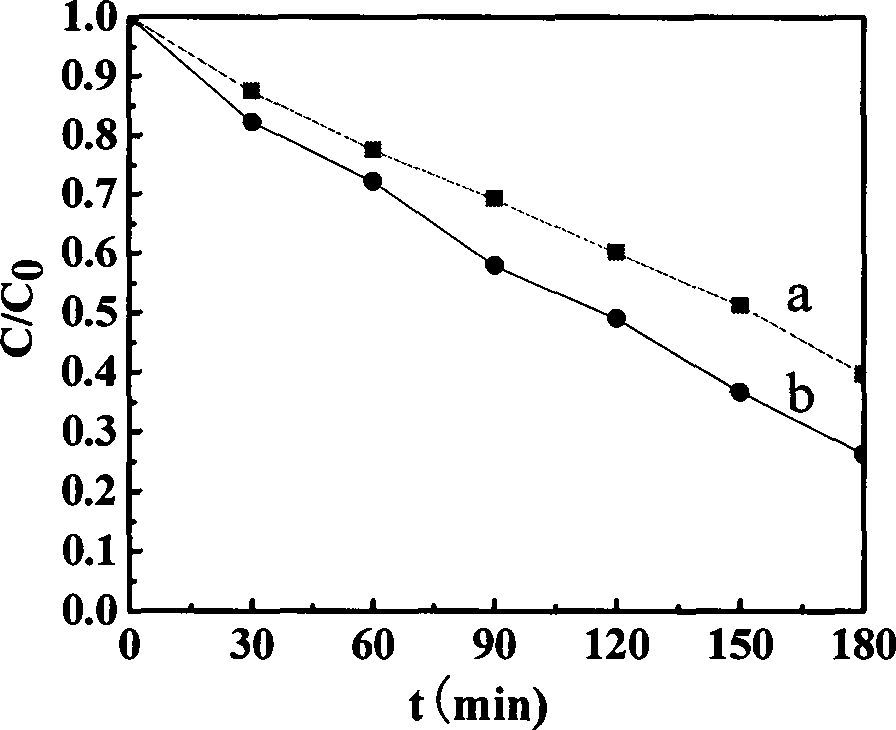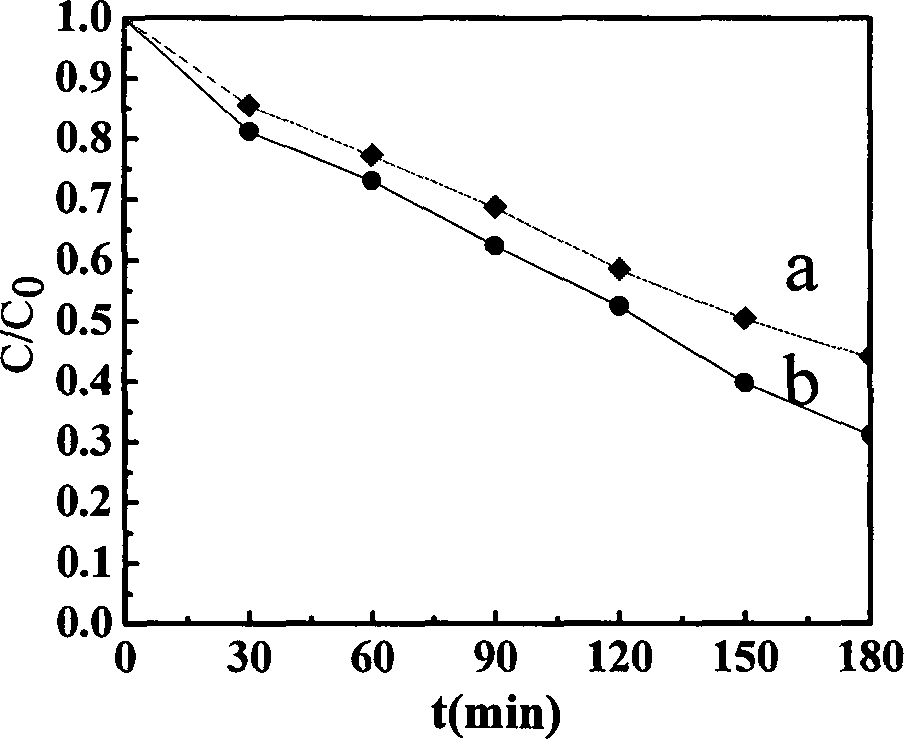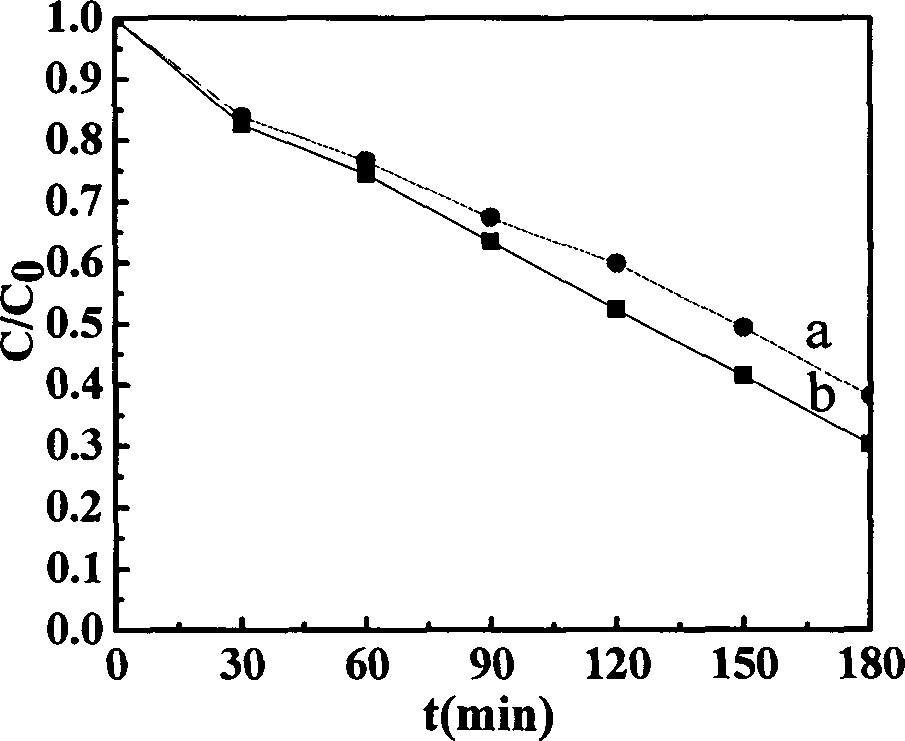Method for preparing molecular imprinting-doped TiO2 with high catalytic degradation activity under visible light
A technology of molecular imprinting and catalytic degradation, which is applied in chemical instruments and methods, physical/chemical process catalysts, chemical/physical processes, etc., can solve problems such as invention patent blanks, improve utilization rate, improve the ability to degrade organic pollutants, The effect of improving the adsorption capacity
- Summary
- Abstract
- Description
- Claims
- Application Information
AI Technical Summary
Problems solved by technology
Method used
Image
Examples
Embodiment 1
[0021] (1) S-doped TiO 2 The synthesis of: under ice bath conditions, first TiCl 4 Add to ice water dropwise, and then add Na at a molar ratio of 1% to the titanium source 2 SO 4 , heated to reflux for 4 hours, aged for 2 hours, then the obtained white substance was centrifuged, washed with water, washed with ethanol, dried at 80°C, and finally roasted at 450°C for 3h to obtain S-doped TiO 2 .
[0022] (2) Molecularly imprinted-doped TiO 2 Synthesis: Add 0.023g p-phenylenediamine and 0.01g salicylic acid into 40mL deionized water, stir for 30min, adjust the pH of the solution to 1, then add 0.2g S doped TiO 2 , continue to stir for 30min, add 0.045g ammonium persulfate under ice bath conditions, stir for 4h under ice bath, centrifuge the solution after reaction, first use Na 2 CO 3 Wash with solution, wash with water, and finally dry at 50°C to obtain molecularly imprinted-doped TiO 2 catalyst.
[0023] (3) Molecularly imprinted-doped TiO 2 Degradation of organic poll...
Embodiment 2
[0025] (1) S-doped TiO 2 The synthesis of: under ice bath conditions, first TiCl 4 Add to ice water dropwise, and then add Na at a molar ratio of 1% to the titanium source 2 SO 4 , heated to reflux for 4 hours, aged for 2 hours, then the obtained white substance was centrifuged, washed with water, washed with ethanol, dried at 80°C, and finally roasted at 450°C for 3h to obtain S-doped TiO 2 .
[0026] (2) Molecularly imprinted-doped TiO 2 Synthesis: Add 0.046g p-phenylenediamine and 0.02g o-chlorophenol into 40mL deionized water, stir for 30min, adjust the pH of the solution to 2, then add 0.2g S doped TiO 2 , continue to stir for 30min, add 0.18g ammonium persulfate under ice bath condition, stir under ice bath for 2h, centrifuge the solution after reaction, first use Na 2 CO 3 Wash with solution, wash with water, and finally dry at 50°C to obtain molecularly imprinted-doped TiO 2 catalyst.
[0027] (3) Molecularly imprinted-doped TiO 2 Degradation of organic pollut...
Embodiment 3
[0029] (1) S-doped TiO 2 The synthesis of: under ice bath conditions, first TiCl 4 Add to ice water dropwise, and then add Na at a molar ratio of 1% to the titanium source 2 SO 4 , heated to reflux for 4 hours, aged for 2 hours, then the obtained white substance was centrifuged, washed with water, washed with ethanol, dried at 80°C, and finally roasted at 450°C for 3h to obtain S-doped TiO 2 .
[0030] (2) Molecularly imprinted-doped TiO 2 Synthesis: Add 0.0156g p-phenylenediamine and 0.0133g o-nitrophenol into 40mL deionized water, stir for 30min, adjust the pH of the solution to 0.5, then add 0.2g S-doped TiO 2 , continue to stir for 30min, add 0.45g ammonium persulfate under ice bath condition, stir under ice bath for 6h, centrifuge the solution after reaction, first use Na 2 CO 3 Wash with solution, wash with water, and finally dry at 50°C to obtain molecularly imprinted-doped TiO 2 catalyst.
[0031] (3) Molecularly imprinted-doped TiO 2 Degradation of organic po...
PUM
 Login to View More
Login to View More Abstract
Description
Claims
Application Information
 Login to View More
Login to View More - R&D
- Intellectual Property
- Life Sciences
- Materials
- Tech Scout
- Unparalleled Data Quality
- Higher Quality Content
- 60% Fewer Hallucinations
Browse by: Latest US Patents, China's latest patents, Technical Efficacy Thesaurus, Application Domain, Technology Topic, Popular Technical Reports.
© 2025 PatSnap. All rights reserved.Legal|Privacy policy|Modern Slavery Act Transparency Statement|Sitemap|About US| Contact US: help@patsnap.com



